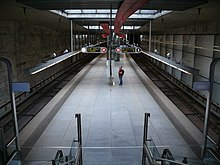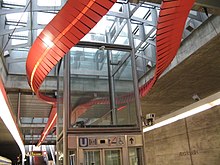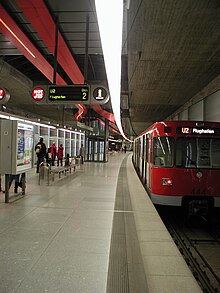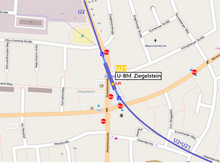Brick underground station
The Ziegelstein underground station (abbreviation: ZI ) is the 38th underground station of the Nuremberg underground and was opened on November 27, 1999. It is 945 m from the Herrnhütte underground station and 2388 m from the Flughafen underground station . In the direction of the airport, there is a parking and sweeping facility at the train station. The underground station is named after the Nuremberg district of Ziegelstein , which was incorporated in 1920 and in which it is located. It is used by around 9,800 passengers every day.
location
The train station is located in the Ziegelstein district of Nuremberg and extends underground in a south-north direction under Fritz-Munkert-Platz and Ziegelsteinstraße between Bierweg and Otto-Lilienthal-Straße. The south staircase and the elevator lead to Fritz-Munkert-Platz, the north staircase to the west side of Ziegelsteinstrasse.
Building and architecture
The station structure is 140 m long, 15 m wide and 9 m deep (single depth). The construction work for this began on September 23, 1996 and was carried out in the open construction method with Berlin shoring . In order to maintain traffic on Ziegelstein and Rathsbergstrasse during the construction work, auxiliary bridges were built over the excavation pit.
The building materials steel and glass were used as architectural design elements according to the concept of Professors Johannes Peter Hölzinger and Josef Reindl. The platform walls are clad with backlit glass panels. A light band of red LED lights leads from each stairway into the station and uses a slowing down or accelerating light wave to indicate that underground trains are arriving. Three glass fields were built into the platform ceiling, which can be walked on on the surface and which provide daylight to the platform level. The elevator is also built into one of these fields.
Lines
| line | course |
|---|---|
|
|
Röthenbach - Hohe Marter - Schweinau - St. Leonhard - Rothenburger Straße - Plärrer - Opera House - Central Station - Wöhrder Wiese - Rathenauplatz - Rennweg - Schoppershof - Nordostbahnhof - Herrnhütte - Ziegelstein - Airport |
- Transfer options
Others
Scenes for the music video Forever by the trance formation Dee Dee were filmed in the subway station . The recordings were produced by AVA Studios in Nuremberg under the direction of Alexander Diezinger.
literature
- City of Nuremberg / Building Department (Ed.): U-Bahn Nuremberg 15 . Press and Information Office of the City of Nuremberg, Nuremberg 1999.
- Michael Schedel: Nuremberg U-Bahn Album . Robert Schwandl Verlag, Berlin 2007, ISBN 3-936573-11-5 .
Web links
- Local area map on the sides of the VGN (PDF; 103.14 KB)
- Station description on local traffic Franconia (private)
- Station pictures on cityverkehr.de (private)
Individual evidence
- ↑ Overview: These are the most used underground stations in Nuremberg on nordbayern.de, from December 27, 2019, accessed on January 6, 2020
- ↑ Music video for Forever
Coordinates: 49 ° 29 ′ 6 ″ N , 11 ° 6 ′ 19 ″ E









